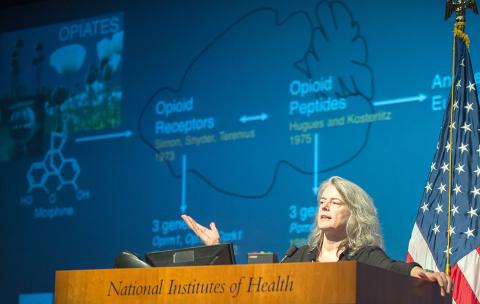Uncloaking a ‘Magical Substance’
Kieffer Dissects Opioid Effects on the Brain

Photo: Leslie Kossoff
For almost as long as we’ve known about the powerful spell opium can cast on a user, scientists have been trying to learn precisely how the drug operates in the body, particularly in the brain. According to recent Wednesday Afternoon Lecture Series guest Dr. Brigitte Kieffer, researchers are closer than ever to understanding, witnessing, mimicking and perhaps predicting opioids’ work within the gray matter.
“Opium is kind of a magical substance that seems to relieve any kind of pain—physical pain, mental pain, social pain—and produces euphoria,” said Kieffer, who began her lecture, “Opioid Receptors and Brain Function,” by briefly tracing the drug back to its botanical origins thousands of years ago.
A large portion of opium’s mystery was revealed about 200 years ago, Kieffer continued, when a German chemist discovered its active ingredient. Morphine, she said, was shown to produce a “highly efficient analgesia, was a strong painkiller—and is still the strongest painkiller today—but also had strong addictive liability…So the holy grail in the field since then has been to find as good a painkiller as morphine, but one that would be devoid of the addictive liability.”
Kieffer, a long-time NIH grantee and professor in the department of psychiatry at McGill University, was making her second visit to NIH in recent months. She had presented a shorter talk as part of a multi-institute-sponsored symposium, “The Opioid Crisis and the Future of Addiction and Pain Therapeutics: Opportunities, Tools and Technologies” in February.
NIH director Dr. Francis Collins introduced the French molecular neurobiologist as “a giant in the study of the opioid system in the brain, a topic of considerable current interest and importance given the crisis we face in this country of opioid overuse and addiction and opioid overdose deaths.”
The Brain on Opioids
“This is your brain,” declared the speaker, holding an egg up to the camera. “This is your brain on drugs,” he went on, cracking the egg into a sizzling skillet. “Any questions?” he deadpanned.
To people of a certain age, that 1980s-era public service announcement by the Partnership for a Drug-Free America offered a lasting image of the damaging effects of drug use.
To scientists—and perhaps neuroscientists in particular—it could easily have been throwing down a gauntlet: What does the brain really look like on opioids?
Opium has been a societal challenge for decades, Kieffer recounted, describing the Opium Wars in the mid-19th century and today’s opioid crisis. Since 2000, she said, opioid over-prescription for pain relief has led “many, many people to become addicted to opioids and to transition to heroin or fentanyl use and this alarming increase in overdose.

Photo: Leslie Kossoff
"During all these years,” Kieffer noted, “neuroscience has dramatically evolved and we have discovered a fascinating opioid neuronal system.”
Morphine acts by binding on the brain. In 1973, researchers identified opioid binding sites, then known as “opioid receptors.” It took about 40 years, from the identification of binding sites, through the isolation of the first opioid receptor gene, to crystallography of the encoded receptor protein and the resolution of receptor structure.
Kieffer, Collins noted, “was the first to isolate a gene encoding an opioid receptor, research that led to much of what the field now understands about how opioids work at the molecular level…Her work has been transformative.”
Familiar Family
“We know a lot about this protein,” Kieffer said. “We know it atom by atom. These receptors belong to the big G-protein-coupled receptor family. They are extremely important as biomedical targets. Half of the drugs used to treat people are agonists or antagonists of G-protein-coupled receptors. We can think of the opioid system as a system that exists in our brain to teach us beneficial behaviors and help us cope with stress. This system is important to regulate reward and aversion processes. It’s also a system that is extremely important to reduce pain and cope with stress.”
Kieffer’s talk covered opioid receptor physiology, in both mood state and drug abuse, homing in on the mu opioid receptor (MOR) in brain circuits. She showed studies identifying MOR as a “single target that mediates both analgesic and adverse [addictive] effects of opioids used in the clinic or abused in the streets.
“MOR is a target to kill pain and many strategies are underway to try to reduce adverse effects mediated by activated mu receptors,” Kieffer said. She recommended more organism-level studies for drug development.
Using knockout mice, “we demonstrated that there is an important role for the mu opioid receptor—beyond drug abuse—that has to do with natural reward,” such as mother-child bonding, Kieffer said.
MOR Complex
Her group also has learned more about two other opioid receptors, and how the three each “contribute very differently to all facets of addiction” and have “distinct roles in hedonic homeostasis and emotional control.”
In addition, Kieffer suggested more study of opioid peptides produced by our brain, which naturally bind and activate the receptors. “We know much less about the peptides compared to what we know about the receptors,” she said.

Photo: Leslie Kossoff
Kieffer explained that scientists had hoped to find that receptors had one designated job, but MOR’s role proved to be more complicated.
“MORs facilitate drug-seeking and taking in reward circuits,” she said. “MOR function and adaptation to opioids in aversion centers is key to ‘the problem.’”
Concluding her talk, Kieffer mentioned her group’s new approach, translational neuroimaging, to view receptor function and brain connectivity.
“Gene-to-connectome mapping is feasible in the mouse,” she said. “Brain network analysis is at the crossroads of mechanistic and biomarker research.”
Currently researchers are examining how morphine, fentanyl and buprenorphine affect the brain. In the long term, Kieffer said, “this work will help scientists better understand opioid effects on the brain and predict behavioral effects of a drug.”
